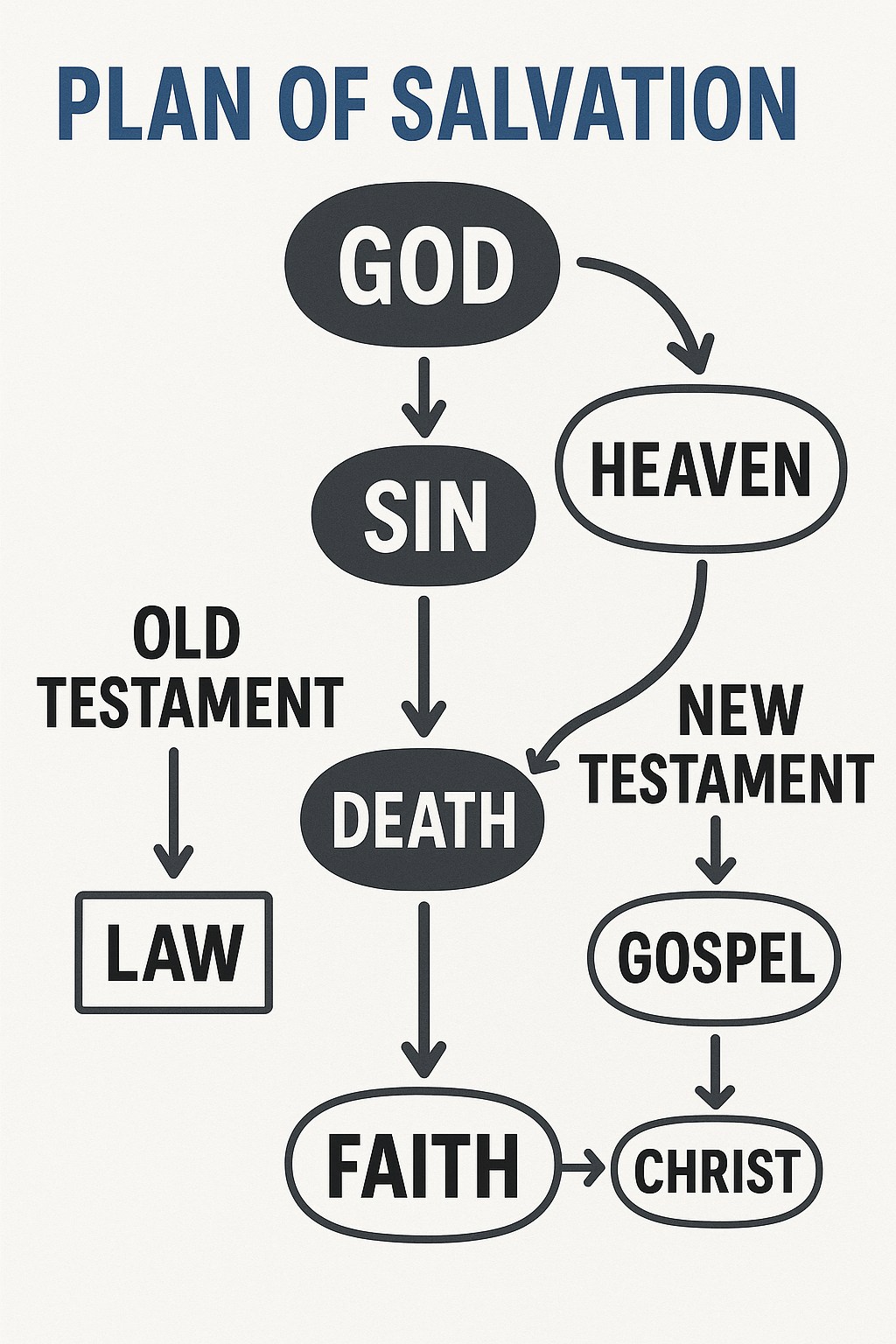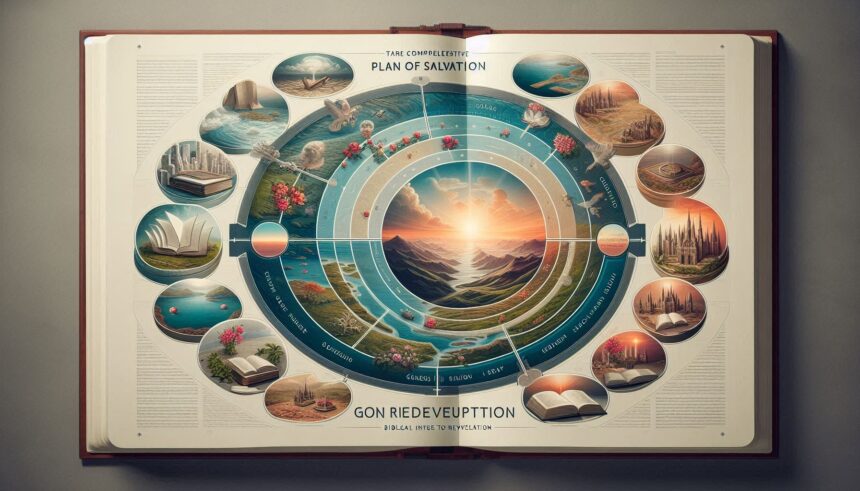Salvation Plan: Understanding God’s Redemptive Path
The plan of salvation diagram offers a visual representation of God’s redemptive plan for humanity, spanning from the Old Testament’s promises to the New Testament’s fulfillment. This diagram of plan of salvation serves as a roadmap, guiding believers through the journey of faith, repentance, and eternal life.
The Foundation: Creation and the Fall
God’s Perfect Creation
In the beginning, God created a perfect world (Genesis 1:31). Humanity was made in His image, designed for fellowship with Him.
The Fall of Man
However, sin entered through Adam and Eve’s disobedience (Genesis 3), leading to separation from God. This pivotal event necessitated a plan for redemption
Old Testament Foreshadowing
Promises of a Savior
God’s plan for salvation was evident early on. In Genesis 3:15, He promised a descendant who would crush evil. Prophets like Isaiah spoke of a coming Messiah (Isaiah 53).
Symbolic Acts
Events like the Passover (Exodus 12) symbolized deliverance through blood, pointing to Christ’s sacrifice. The bronze serpent lifted by Moses (Numbers 21:9) prefigured Jesus being lifted on the cross.
New Testament Fulfillment
Jesus: The Fulfillment
Jesus’ life, death, and resurrection fulfilled Old Testament prophecies. He declared Himself the way to the Father (John 14:6).
Salvation Through Faith
The New Testament emphasizes salvation by grace through faith (Ephesians 2:8-9). Belief in Jesus’ sacrifice brings forgiveness and eternal life (John 3:16).
Visualizing the Plan: Diagrams and Illustrations
The Plan of Salvation Diagram
Various plan of salvation diagrams illustrate stages like pre-mortal existence, mortality, and eternal life. These visuals aid in understanding God’s overarching plan.
Educational Tools
Resources like the printable diagram from A Lively Hope provide interactive ways to study and teach the plan of salvation.
Scholarly Insights and Christian Literature
Theological Perspectives
Scholars like Paul Y. Hoskisson have explored the plan of salvation in the context of the Old Testament, highlighting its consistency throughout scripture .
Recommended Readings
- The Plan of Salvation by L. Tom Perry
- The Gospel of Jesus Christ in the Old Testament by D. Kelly Ogden, Jared W. Ludlow, and Kerry Muhlestein
Living the Plan: Application Today

Embracing the Journey
Understanding the plan of salvation diagram isn’t just academic; it’s a call to action. Believers are invited to live in accordance with God’s plan, embracing faith, repentance, and discipleship.
Sharing the Message
Equipped with knowledge and visual tools, Christians can effectively share the message of salvation, guiding others through the diagram of plan of salvation towards a relationship with God.
The Fall of Man: Humanity’s Need for Salvation
The Genesis Account
In Genesis 3, Adam and Eve’s disobedience introduced sin into the world, resulting in separation from God. This event, known as the Fall, underscores humanity’s need for redemption.
Consequences of the Fall
The Fall brought about spiritual death and a propensity to sin. Romans 5:12 states, “Therefore, just as sin came into the world through one man, and death through sin, and so death spread to all men because all sinned.”
The Promise of Redemption: Old Testament Insights
Covenant with Abraham
God’s covenant with Abraham (Genesis 12:1-3) promised that through his offspring, all nations would be blessed. This foreshadowed the coming of the Messiah.
Prophetic Revelations
Prophets like Isaiah foretold the suffering servant who would bear the sins of many (Isaiah 53). These prophecies laid the groundwork for understanding the Messiah’s redemptive role.
The Fulfillment in Christ: New Testament Perspectives
Incarnation and Ministry
The New Testament reveals Jesus as the fulfillment of Old Testament prophecies. John 1:14 declares, “And the Word became flesh and dwelt among us.” His teachings, miracles, and sinless life affirmed His divine nature.
Crucifixion and Resurrection
Jesus’ death on the cross paid the penalty for sin, and His resurrection conquered death. 1 Corinthians 15:3-4 emphasizes this: “Christ died for our sins… he was buried… he was raised on the third day.”
The Plan of Salvation Diagram: Visualizing God’s Redemptive Plan
Visual aids like the plan of salvation diagram help believers grasp the sequence of events in God’s redemptive plan. These diagrams typically include:
- Pre-Mortal Existence: Jeremiah 1:5 suggests God’s knowledge of individuals before birth.
- Mortal Life: A period of testing and growth (2 Nephi 2:25).
- Death and Spirit World: The spirit continues after physical death (Luke 23:43).
- Resurrection: Reuniting of body and spirit in a perfected state (1 Corinthians 15:22).
- Final Judgment: Assessment of one’s life and choices (Revelation 20:12).
- Eternal Destiny: Assignment to a degree of glory based on faithfulness (John 14:2).
Such diagrams are valuable tools for teaching and personal study. Resources like the printable diagram from A Lively Hope provide interactive ways to engage with these concepts .
Theological Insights: Scholarly Perspectives
Scholars have explored the plan of salvation extensively:
- Paul Y. Hoskisson discusses the plan’s presence in the Old Testament, emphasizing its consistency throughout scripture .
- Tyler J. Griffin and Donald B. Anderson highlight the importance of visual representations in understanding the plan’s depth .
These insights enrich our comprehension of salvation’s multifaceted nature.
Living Out the Salvation Plan: Practical Applications
Embracing Faith and Repentance
Believers are called to respond to God’s grace through faith in Jesus Christ and repentance from sin (Acts 2:38).
Participating in Ordinances
Practices like baptism and the Lord’s Supper serve as outward expressions of inward faith, aligning with the salvation plan (Romans 6:4).
Pursuing Discipleship
Living according to Christ’s teachings and growing in spiritual maturity reflect the transformative power of salvation (Ephesians 4:15).
Conclusion
The plan of salvation diagram encapsulates the journey from creation to eternal life, highlighting God’s unwavering love and provision for humanity. By studying scripture, engaging with theological insights, and applying these truths to daily life, believers can fully embrace and share the message of salvation.


Leave a Reply
You must be logged in to post a comment.